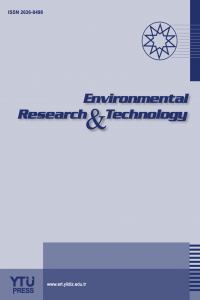Extraction of some heavy metal ions from aquatic solution by banana peel-based biosorbents
Banana peel density of biosorbents, extraction, heavy metal,
___
- [1]. M.C.S. Minello, A.L. Paçó, M.A.U. Martines L. Caetano, A.D. Santos, P.M. Padilha, G.R. Castro, ‘‘Sediment grain size distribution and heavy metals determination in a dam on the Paraná River at Ilha Solteira, Brazil.’’ Journal of Environmental Science and Health, Part A, 44(9), 861–865. 2009.
- [2]. M.C.S. Minello, A.L. Pac, R.S.D. Castro, L. Caetano, Padilha, P.M. Ferreira, G. Martines, M.A.U. Castro, G.R, ‘‘Evaluation of heavy metal availability in contaminated sediments from the ilha solteira hydroelectric dam on the parana river at ilha solteira’’, SP, Brazil. Fresenius Environ. Bull. 19, 2210, 2010.
- [3]. Q. Yu, P. Kaewsarn, ‘‘Binary adsorption of copper (ii) and cadmium (ii) from aqueous solutions by biomass of marine algadurvillaea potatorum.’’ Separation Science and Technology, 34(8), 1595–1605. 1999.
- [4]. M. Zhao, J. Duncan, H.R. Van, ‘‘Removal and recovery of zinc from solution and electroplating effluent using Azolla filiculoides.’’ Water Research, 33(6) 1516–1522. 1999.
- [5]. E. Fourest, J.C. Roux, ‘‘Heavy metal biosorption by fungal mycelial by-products: mechanisms and influence of pH’’, Applied Microbiology and Biotechnology, 37(3) 399–403, 1992.
- [6]. R. Apiratikul and P. Pavasant. Batch And Column Studies of Biosorption of Heavy Metals By Caulerpa Lentillifera. Bioresource Technology, 99(8) 2766–2777. 2008.
- [7]. F. Özdemir, D. Ramazanoğlu, ‘‘Atık muz kabuğu, biber sapı ve kızılçam odun unu kullanılarak biyoplastik kompozit üretimi.’’ Turkish Journal of Forestry, 20 (3), 267-273. 2019a.
- [8]. F. Özdemir, D. Ramazanoğlu, ‘‘Farklı biyokütlelerden elde edilen nişasta ile akıllı biyoplastik malzeme ve odun biyoplastik kompozit üretimi.’’ Bartın Orman Fakültesi Dergisi, 21(2), 377 - 385. 2019b.
- [9]. ASTM D 792 2004. Density and specific gravity (relative density) of plastics by displacement, ASTM International, West Conshohocken, PA.
- Yayın Aralığı: Yılda 4 Sayı
- Başlangıç: 2018
- Yayıncı: Yıldız Teknik Üniversitesi
Doğu RAMAZANOĞLU, Zaman Adnan MOHAMMED, Khalid Ali MAHER
Tohid IRANİ, Hamid AMİRİ, Sama AZADİ, Mohsen BAYAT, Hedieh DEYHİM
Achimota DİCKSON, Joseph ARULEBA, Joseph Oyinbrakemi TATE
Ümmü Ayca BİLGİ, Ece Ümmü DEVECİ
Gulizar KURTOGLU AKKAYA, Muhammed Kamil ÖDEN
Abdulkadir ÇAĞLAK, Nouha BAKARAKİ TURAN, Hanife ERKAN, Güleda Önkal ENGİN
